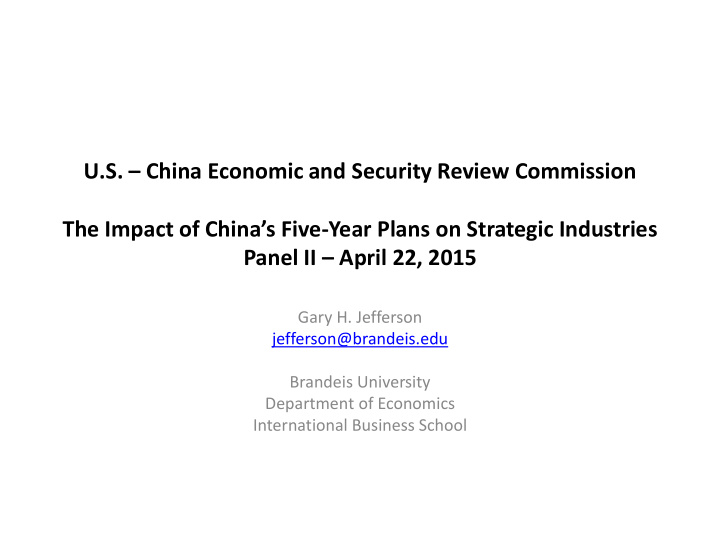



U.S. – China Economic and Security Review Commission The Impact of China’s Five -Year Plans on Strategic Industries Panel II – April 22, 2015 Gary H. Jefferson jefferson@brandeis.edu Brandeis University Department of Economics International Business School
Shows how the labor productivity growth (gLP) of Chinese firms responds to the technology gap with the international frontier (i.e., the U.S.)…the larger the gap the greater gLP.
Shows a similar relationship for the rate of growth of catch-up (i.e., gap reduction) relative to the size of the U.S.-China productivity gap – 1. industries to the NW (mostly iron and steel due to relatively slow U.S. LP growth); 2. industries to the SE (petroleum and coal products, chemicals, apparel, computer and electronic products due to relatively high U.S. LP growth.
Reversals – 1998-2007 rising capacity utilization in the iron and steel industry; sharp post- 2007 decline in capacity utilization…
12 th 5- year plan: Ch. 9 (sec. 4) “Drive advantaged enterprises to carry out alliance, x-regional merger and reorganization, and increase industry concentration with an emphasis on…iron and steel (and automobile, cement, machine building…). The problem… (source: Dr. Markus Taube Univ. of Duisburg-Essen)
Table 3. Has China developed its own internal frontier? 1. Top decile Chinese firms > U.S. average (3/18) and top 10 Chinese firms >> U.S. average (15/18) 2. 3-firm comparisons (publicly traded companies): U.S./China sales/employee advantage = 2.28
What drives the catch-up? 1. Domestic firms with an edge benefit the most from FDI and import competition → separation effect with break out firms… 2. Five (5) of top 8 import sectors are also top 5 mfg. export sectors 3. The computer chips sector is on track…
Table 6. China’s innovation system…achievements; challenges numerical catch-up; quality lag 1. China as an “innovative society”…R&D/GDP = 2.0% vs. U.S. 2.8% 2. basic research share…5.0% vs. U.S. 18% 3. government share…21.6% vs. U.S. ~29% Table 5. Intramural R&D Expenditure by Performing Sector (billion yuan) year total Basic (%)** Applied (%)** Experimental Development (%)** 1995 - Total 34.87 (0.57%)* 1.81 (5.2%) 9.20 23.86 2007 – Total 2012 - Total 1029.84 (1.98)* 49.88 (4.8%) 116.20 (11.3) 836.76 (83.9) Enterprises 784.22 (76.2%) 0.71 23.89 759.63 (96.9%) Government sector (i.e., 154.89 (15.0%) 19.79 (7.8%) 46.93 (30.3%) 88.17 (51.9%) Research institutions) Higher education 78.06 (7.6%) 27.57 (35.3%) 40.27 (51.6%) 10.22 (13.1%) Private non-profit 12.67 (1.2%) 1.81 5.11 5.74 Intramural R&D by Source (billion yuan) year Government Self-raised by Foreign funds Other funds enterprises 2007 – 371.02 2012 – 1029.84 222.13 (21.6%) 762.50 (74.0%) 10.04 (1.0%) 35.16 (3.4%) Of which Beijing - 106.34 56.60 (53.2%) 36.86 4.79 8.08 Liaoning – 39.09 9.00 (23.0%) 29.64 0.08 0.36 Jiangsu – 128.79 13.88 (10.8%) 109.86 0.96 4.09 Zhejiang – 72.29 6.04 (8.3%) 64.44 0.31 1.47 *Share of GDP; **share of total R&D expenditure
A matter of concern…
Key points re: patents and publications: 1. China has surpassed the U.S. in total patents filed and granted 2. China has surpassed the U.S. in invention patents granted to domestic filers 3. China has surpassed the U.K. in USPTO patents granted; lags S. Korea and Taiwan 4. China ranks 2 nd in cited papers; 7 th in total citations
Comparisons/weaknesses • All OECD countries dedicate substantially larger portions of R&D to basic research (3-5x) • Enterprise sector: Declining patent production returns to R&D …also, at the firm level weak correlation between patenting and productivity growth. Local government patenting incentives may be unhelpful, e.g., incentives for patent grants appear to motivate filers to narrow the claims on their patent applications → lower quality • Higher education sector: All OECD countries dedicate larger portions of higher education which performs most of basic research (2-3x) Limits to autonomy-creativity in higher-ed (hierarchical/muddled incentives). • Research institute sector: Strong on publications; surprisingly weak on patents 15% of total R&D; 7.8% of basic research; 5.5% of total invention patents granted • Notable Innovations: Chinese version of Bayh-Dole Act – enables recipients (i.e. universities and research institutes to secure patents for government-funded research) University-corporate collaborations (e.g., Tsinghua Unigroup with acquisitions- partnerships with Chip Makers, including Spreadtrum in which Intel has a 20% share)
U.S. - recommendations • Increase spending on basic research – retain this comparative advantage as long as possible. • Anticipate that it is very likely that China will catch- up…i.e., It is very unlikely that 25 years from now, the U.S. will be able to out-spend China on innovation and defense or…over the following 25 years be able to out-perform China in these areas. To the extent possible seek to establish coordination and/or joint limits on such spending…
http://en.wikipedia.org/wiki/Frascati_Manual • The (OECD) Frascati Manual classifies research into three categories: • Basic research is experimental or theoretical work undertaken primarily to acquire new knowledge about observable phenomena and facts, not directed toward any particular use. • Applied research is original investigation to acquire new knowledge directed primarily towards a specific practical aim or objective. • Experimental development is systematic effort, based on existing knowledge from research or practical experience, directed toward creating novel or improved materials, products, devices, processes, systems, or services.
Recommend
More recommend